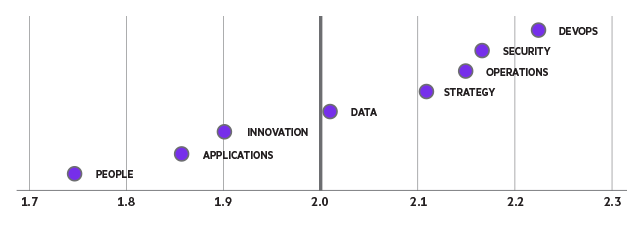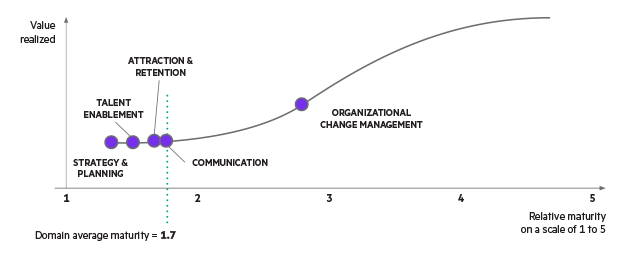Investing in people is key to successful transformation
People can be your most important catalyst for digital transformation-or the greatest obstacle. When people-related challenges to transformation progress emerge, the problems are usually very easy to identify but much harder to solve.
The challenge is not awareness. Organizations realize that cloud transformations are hard and that they need highly skilled, motivated staff to carry out the projects. But they still struggle to build out the processes to create those staffs and, as a result, hit other project-focused goals.
By celebrating accomplishments and innovation frequently, you reinforce role-model behavior and develop grassroots momentum for change initiatives."Where things standBased on our engagements with customers, we've evaluated enterprise progress in capability in the eight domains making up the HPE Edge to Cloud Adoption Framework.
The People domain is the one in which organizations struggle the most to make progress, with an average maturity of 1.7 on a scale of 1 to 5, where a score of 3 indicates a cloud-ready organization (see Figure 1).
 Figure 1: Organizational maturity in the eight domains of cloud operation model adoption
Figure 1: Organizational maturity in the eight domains of cloud operation model adoptionThat's not to say they're bad employers. They can value employees themselves and aspire to raise their overall talent level but still fall short in the overall delivery of talent-related initiatives. They can create talent development plans but fail to align them to cloud-focused initiatives. And they can pledge to do a better job building a talent base but fail to exercise the organizational muscle to make it happen.
The struggles cloud-focused organizations have on the people front can be tracked to four of these factors (see Figure 2):
- Talent attraction and retention
- Talent enablement
- Communication
- Strategy and planning
 Figure 2: Organizational maturity in the People domain
Figure 2: Organizational maturity in the People domainWhile most organizations at least try to address each of these factors, many don't have the deliberate plans needed to drive complicated cloud transformations.
A methodical approach to identifying well-defined initiatives that can be implemented in measurable increments can go a long way toward addressing people-related obstacles to transformation progress.
Attract and retain: Competing for specialized skillsStart with attracting and retaining talent. In today's competitive IT environments, it's critical for organizations to attract the specialized skills they need. Every company is competing for the same hybrid, public cloud, and edge talent. But organizations are struggling with traditional onboarding techniques. Job searches and exec searches often don't reach people with the right skills. Compensation packages are getting expensive. Geographical requirements are often too rigid.
Across the population of organizations we engage with, those that are lagging in cloud maturity simply aren't effective at acquiring the talent needed to do the job, and they're not extending internal plans to retain the talent they have.
In contrast, leaders on the people front are developing systems to find this talent and sustain it. They have a solid foundation for performance and talent management already in place, and they're adapting it to meet the needs of new areas like hybrid cloud security, hybrid networking, and internet of things. Culture, salary competitiveness, and nonmonetary incentives play a large part in how effective an organization is at talent identification and recruitment success.
Leading organizations are defining new job functions and new practice areas, where exciting growth opportunities can be used to compete for attention. They are attracting talent outside of the traditional full-time equivalent roles by developing strategic relationships for contractors, partners, and other non-FTE workers.

An insurance company we worked with built a program to establish comprehensive insights on skills and proficiencies across the enterprise that allowed it to develop a risk and succession plan and target selective areas in which to acquire public cloud skills externally.
Talent enablement: Modernize training to accelerate upskillingOnce the workforce is in place, organizations need to put plans in place to sharpen skills in important areas across IT-everything from security to infrastructure to application development. Legacy shops usually rely on passive learning techniques like courses, webinars, and prerecorded trainings. But they often have incomplete course catalogs because skills in hybrid cloud and the edge are rapidly evolving. That means they don't have the offerings available to train up people.
The leading organizations in our customer population generate better results by creating learning journeys focused on more measurable, active learning measures. Coaching and mentoring is a long-standing practice that builds confidence in organizations bringing on new sets of tasks, platforms, and responsibilities. They're installing job rotations within roles and contexts.
They're also conducting so-called two-in-a-box techniques whereby experts are brought in from an outside partner to work alongside staff. These extra hands deliver services while also training up staffers to handle tasks related to a new cloud initiative-essentially catching fish while helping the workers learn to catch their own. A top five US bank we worked with employed this approach, emphasizing active learning techniques and modern learner experiences.
Communications: Leading and communicating through changeWe find significant variation in communications capability across our customer population, which impacts transformation effectiveness.
Transformations affect workers in different ways. Organizations that display maturity in this capability are using new platforms, performing new jobs, working new schedules, and often reporting within newly configured team structures.
Where we see issues with communications, organizations are often doing a poor job of explaining the new landscape and helping workers adjust to new expectations. Commitment by leadership to build awareness and a meaningful understanding of changes being made will help prepare and enable staff for the next phases of the transformation journey.
Organizations with effective communications strategies understand that it's important to use communications not merely as a mechanism to update people about changes but also to celebrate individual and team accomplishments. This can be done through internal channels like collaborative communications platforms, newsletters, and internal recognitions. It also helps to leverage external channels like social media and LinkedIn to circulate successes.
By celebrating accomplishments and innovation frequently, you reinforce role-model behavior and develop grassroots momentum for change initiatives.
Strategy and planning: Manage risk and create flexibility through succession planningDespite all the work organizations do to retain employees with roles that are critical to transformation success, employees still leave. They may be making personal choices that have nothing to do with their commitments to their company. So, what happens if one key director or a group of critically important programmers choose to take other jobs? Does the company's transformation suffer?
Among our customer population, leaders and laggards differ significantly in how they conduct succession planning. Laggards don't understand the risk associated with their human capital, and they're often not building out succession plans to absorb exits from critical IT roles. And by not having this plan, business and IT operations can be disrupted.
The first step in addressing this situation is making sure you understand the skills and competencies you have across your organizations. Prepare a risk assessment that evaluates the impact on operational and business continuity if someone important leaves. From the risk assessment, you can build out a succession plan and install cross-training plans to ensure that skill levels in critical areas are backed up within the organization.
Leaders often go a step further. Advanced organizations with highly functioning talent plans have a keen awareness of where these critical roles lie within new practice areas. They set up mechanisms to identify and reward high performers in these critical areas.
In terms of people strategy and planning, leaders also do a better job hiring employees that can help them get the most out of partner resources. For example, if an organization is moving workloads to a public cloud platform like Microsoft Azure or an on-premises cloud like HPE GreenLake, tools, applications, and services are available that can be helpful with specific aspects of the project. Hiring experts in house can develop the necessary knowledge to scale up a project. Or it can work the other way: Consulting with a partner about available technologies and opportunities can inform the organization's plans to add more specialized staff.
People drive successful transformationsSuccessful business and IT transformations require synchronous movements of a lot of critical components. Organizations need to skillfully align functions ranging from strategy to security to data to operations around a common goal of delivering value through cloud and hybrid IT. But transformations aren't performed by functions. They're carried out by people. To reach a mature level in their transformation projects, organizations need to invest in processes that ensure that their people are up to the job.
Read the original article on Enterprise.nxt.
This content was produced by Hewlett Packard Enterprise. It was not written by MIT Technology Review's editorial staff.